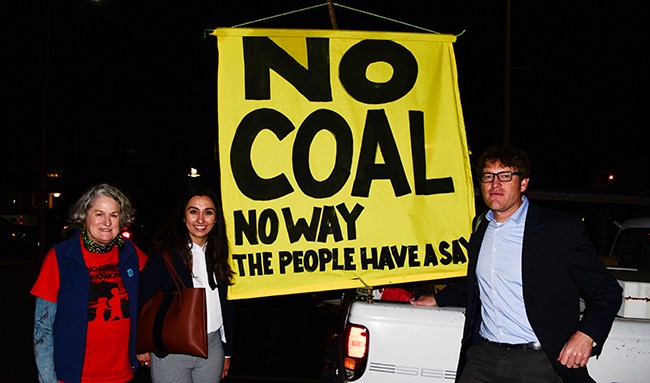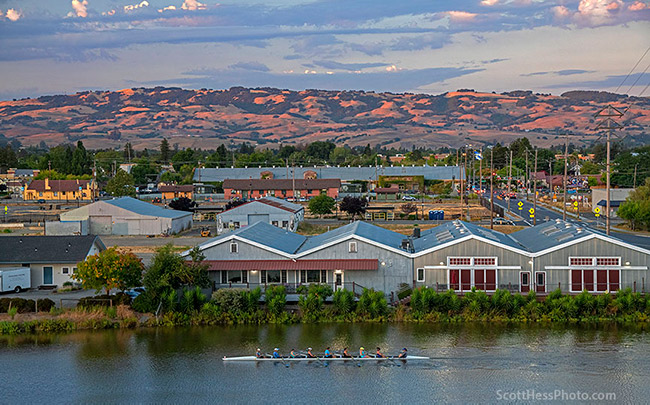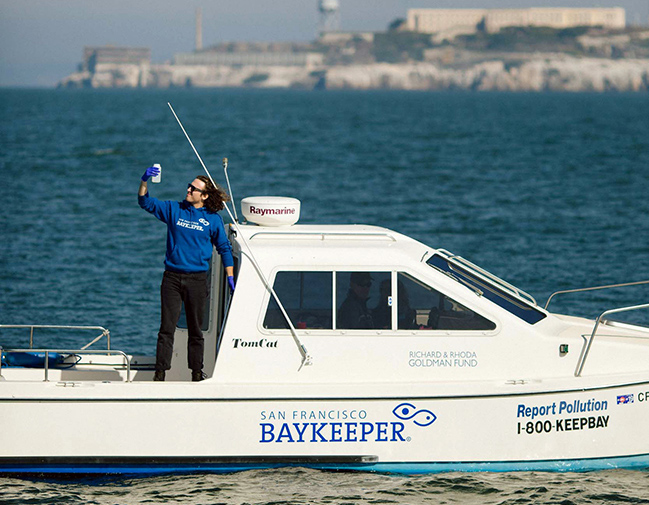 |
| Monthly Update for December 2019 |
|
|
|
|
|
|
Richmond delays protection from dirty coal

The Bay Area's only active coal terminal moves more than a million tons of coal through Richmond, releasing toxic coal dust into nearby neighborhoods and San Francisco Bay. Coal dust causes asthma and other diseases in people, and it contains metals and other pollutants that harm wildlife.
That's why Richmond city officials proposed a new ordinance that would phase out the handling and storage of coal in the city.
But at the ordinance vote on December 3, fossil fuel companies fought back hard, and things got ugly. Our advocates were shocked to hear opponents use rude and racist language for the indigenous activists and environmentalists there to support the ordinance.
After hours of debate and over 100 comments from the public, the council decided to postpone the vote—seemingly in response to threats of retaliatory industry litigation.
"This delay only serves the short-term interests of the coal industry," said Baykeeper Staff Attorney Ben Eichenberg. "Calling for more unnecessary study is nothing more than rearranging deck chairs on the Titanic. The mayor and city council need to act now to protect the Bay and residents' health."
The city council said it plans to reconsider the ordinance again soon. We'll continue advocating for this vote to protect the health of local communities and San Francisco Bay.
Read more about the Richmond coal ordinance.
Pictured, above: No Coal in Richmond's Janet Johnson, Baykeeper Legal Fellow Kayla Karimi, and Baykeeper Staff Attorney Ben Eichenberg outside the Richmond City Council on December 3. Photo by Robert McKinney.
|
|
Preventing a toxic wave of industrial pollution
More than 1,600 industrial facilities around the Bay use and store heavy metals, synthetic chemicals, and hazardous waste in outdoor areas. With each passing day, these toxic materials accumulate on surfaces and structures around the sites.
When the first big storms of the rainy season hit, the built-up contamination washes off in toxic waves—often flowing directly to the Bay or indirectly through drains leading to creeks and rivers.
One example was the Shamrock concrete production facility in San Rafael. Baykeeper's 2015 investigation revealed that the site had been releasing polluted runoff—so Baykeeper took action.
Our scientists and lawyers worked with the company to create a plan to keep the site's polluted runoff out of the Bay. Just in time for the season's first major storms, Shamrock finished installing pollution controls to capture and re-use runoff, rather than letting it reach the Bay.
This is just one success in Baykeeper's systematic campaign to identify and clean up the Bay Area's worst industrial polluters. So far, we've compelled 45 harmful sites (see below) to set up controls and treatment systems to reduce toxic industrial pollution in the Bay.
Read more about how we stop toxic industrial runoff to the Bay.

|
|
Too little (but not too late) for the Petaluma River

In 1975, scientists found that the Petaluma River was so heavily contaminated with E. Coli and other bacteria that it was unsafe to have any contact with the water.
In the 45 years since, little has changed. The river remains dangerously contaminated, with high levels of bacteria showing up in every single water test taken in the river. The Petaluma River feeds into creeks across the North Bay and Marin, and eventually connects with San Francisco Bay.
The local water agency recently approved a plan to address the river's troubling bacteria levels. Unfortunately, their approach doesn't have teeth. It fails to establish where the bacteria pollution is coming from, how much pollution the sources must reduce to improve water quality, or how progress will be monitored and enforced.
"While Baykeeper appreciates the Water Board's goal of improving water quality in the Petaluma River, their plan will not achieve that goal or make the river safer for people and wildlife," said Baykeeper Staff Scientist Ian Wren.
As the plan heads to the State Water Board and EPA for final approvals, Baykeeper will continue to push for a stronger approach. We can't let another 45 years go by before it's safe to swim in the Petaluma.
Read more about pollution in the Petaluma River.
Photo by Scott Hess, Flickr/CC
|
|
Investigating pollution by land, air & water

Gathering evidence is the first step when Baykeeper investigates polluters harming San Francisco Bay. That's why Baykeeper's scientists and attorneys regularly patrol the Bay.
Investigating Bay pollution is complex work, and we don't do it alone. We're grateful to our team of 12 volunteer skippers who pilot the Baykeeper boat and contribute a lot of hours to keep the boat running.
Since some polluters can't be investigated from water, Baykeeper takes to the air. We partner with Lighthawk Conservation Flying's volunteer pilots who take us up in their small planes. And Autonomous Imagery's volunteer drone operators help us detect pollution that can only be seen from above.
We recently received some exciting new tools to help us investigate Bay pollution. Oru Kayak just announced it will donate one of their foldable, portable kayaks, aptly called "The Bay," to get us to places our boat can't reach. And our newest partner, Insta360, donated camera gear that will help us gather evidence by recording live video of our patrols from aboard the Baykeeper boat.
We're immensely grateful to all these partners who help Baykeeper find and stop polluters!
Above, a video still from the Insta360 camera aboard the Baykeeper patrol boat.
|
|
Thank you to our Giving Tuesday & Anchor Happy Hour donors!

On Giving Tuesday this year, we asked for support for our amazing scientists, field investigators, and legal staff who work every day to defend San Francisco Bay.
We're happy to announce that you helped us raise just over $10,000! Thank you! Your support powers our patrols, pollution investigations, and advocacy for the Bay.
Thanks also to everyone who came to the Anchor Brewing happy hour to celebrate with us and enjoy fresh pints of the new Baykeeper IPA! It was delicious, and we had a blast.
Fortunately, it's never too late to make your Giving Tuesday gift. Give by December 31 to make your tax-deductible gift for 2019. Support a protected San Francisco Bay with your gift to Baykeeper.
Photo by Erin Conger
|
|
We're hiring! Join the Baykeeper team
Baykeeper is seeking an experienced Communications Director to lead our communications program. Reporting to the Executive Director, the Communications Director will set and guide communications strategy to raise awareness of Baykeeper's work.
This is a new director-level, leadership position instrumental to the success of Baykeeper's communications program and our overall mission to defend the Bay.
Read more about our new Communications Director position and learn how to apply.
Baykeeper is also looking for an enthusiastic event intern to help produce our two biggest 2020 events, the Baykeeper Dinner and the Bay Parade.
The ideal candidate for this position is passionate about environmental protection and looking to develop skills in event production. This is an unpaid volunteer internship. Arrangements can be made to meet requirements for class credit.
Read more and learn how to apply to be our Event Intern.
|
|
 Baykeeper on patrol Baykeeper on patrol
Baykeeper Field Investigator Cole Burchiel is busy planning for our annual aerial survey of the King Tides in the Bay.
These extra-high tides occur every year when the earth's orbit aligns at its closest point to the sun and moon, resulting in extra gravitational pull. This natural phenomenon isn't caused by sea level rise—but a King Tide can provide a preview of which parts of the Bay Area are especially vulnerable to flooding from high water levels.
Documenting the range and intensity of these annual high tides can help predict the impacts of sea level rise on vulnerable shoreline sites in coming decades.
The upcoming King Tides will occur on January 10-12 and February 8-9. Cole is working with our drone partners, Autonomous Imagery, to plan the flight path. Then we'll take a flight with our LightHawk pilot volunteers to monitor the tides' effect on shoreline areas.

|
|
Photo above and at top by Robert Most
|
|
 |
|